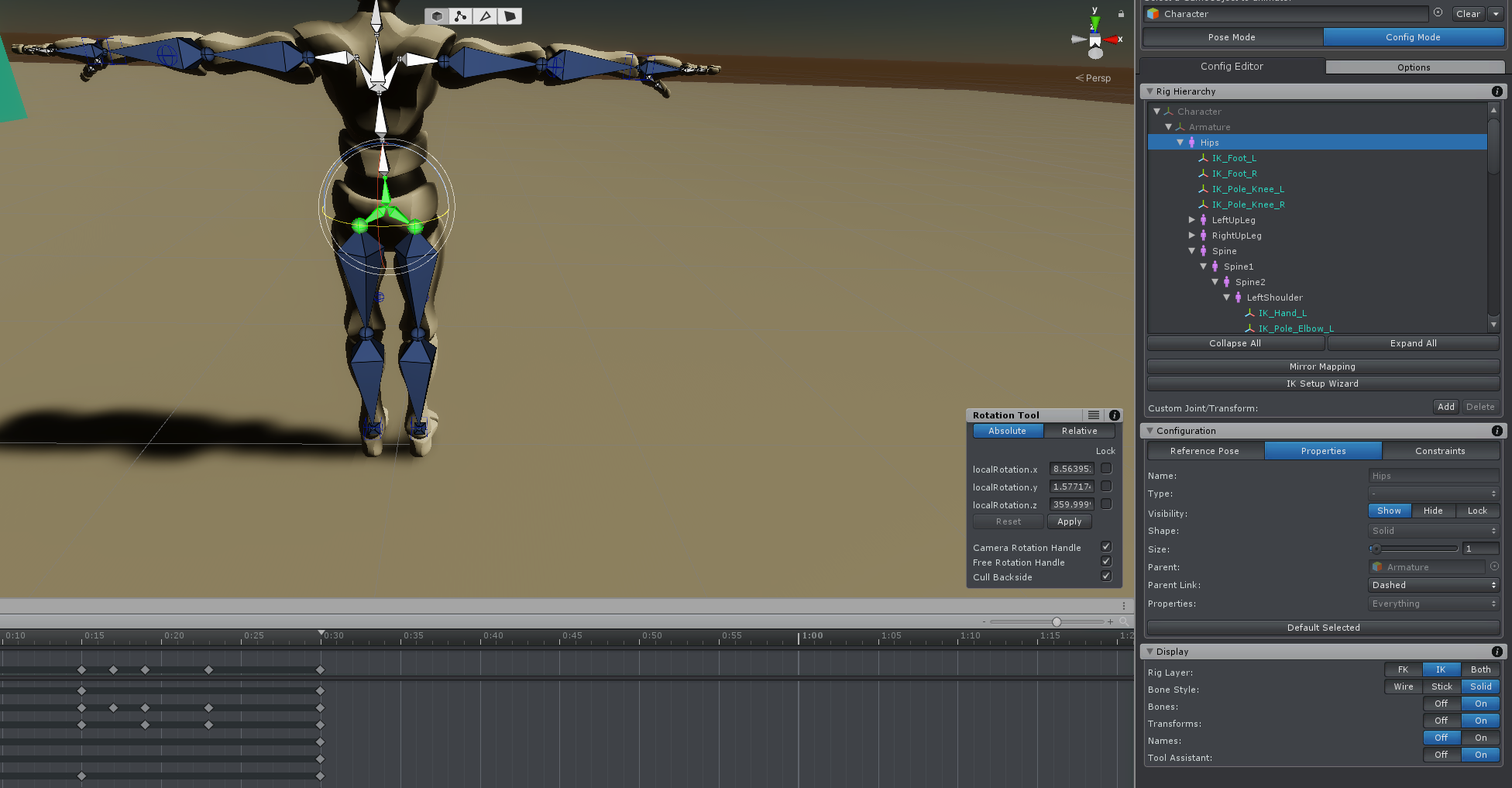
 Hips rotation - rotates entire body, I'm using IK
Hips rotation - rotates entire body, I'm using IK

Hey,
when I rotate the hips, my entire body rotates along. I've done the IK setup wizard, and the character is using IK. From my understanding, his hips shouldn't rotate the entire body along anymore?

select the feet ik postilion things square cube then in in the pose editor there is a small tick box ik pinned this will lock the feet

 import clips
import clips
hi peter when you import clips is there away to select several clips
iv'e tried ctrl shift etc but can only seem to add one clip at a time thanks

Hi Robin,
thank you very much for your support request.
If I recall correctly, Unity's file dialog API doesn't support multi selection. But you can select multiple clips in Unity's Project Window and drag & drop them to the import window.
Please let me know in case you have any follow-up questions.
Best regards,
Peter

 Shorten my clip
Shorten my clip
Have a simple questions:
I've created a running animation, and am happy with it. However when increasing the playback I realise it definitely looks better at 1.5x speed. How can I shorten the clip I have right now of one second, so that it matches the speed that can be seen in playback?

Nevermind! by searching for "speed" instead of shorten I found the answer here! Appreciate it.

 Right hand sliders disabled
Right hand sliders disabled
Hi Peter,
actually I've a problem with the right hand sliders. They are always disabled for the right hand, left hand sliders work as expected. While I've a mismatch between the transform names of my Synty Model and Mixamo animations I've renamed my transform of the model of the right hand by removing the blanks in the name string (i.e: finger_01 1 to finger_011 ect.).
After set-up the model all renamed transforms of the right hand are locked in UMotion. I've activated them in the Config mode and set their parents from hidden to solid equivalent to left hand settings. Now I see the bones, but the sliders are still disabled...
Any idea what is missing? Thanks in advance.
Best regards
Christian

Hi Christian,
thank you very much for your support request.
The problem is, that due to the renaming these bones are not mapped to humanoid bones anymore (the mapping is done via the humanoid avatar and is based on the bone name). If you want to change the naming of your bones, do it in your source file (e.g. in the *.fbx file) using a 3D modeling application of your choice.
Please let me know in case you have any follow-up questions.
Best regards,
Peter

 Mouth and lips
Mouth and lips
Hi, it is possible some way change lips an mouth positions - open/close?
In default pose mouth is closed, but when I import some clips, mouth is opened and I need shut up this women...


 Unity 2019.3.8f1 Issues
Unity 2019.3.8f1 Issues

I am trying for the first time with uMotion free and when I open the example scene, the characters are all stretched out and whacky. Seems like it doesn't work in 2019 Unity. Any ideas?

Hi,
thank you very much for your support request.
All versions of Unity 2019 are fully supported by UMotion (including Untiy 2019.3.8f1). Looks like Robot Kyle wasn't imported correctly (it probably already existed in your project with different import settings).
My recommendation: Delete all UMotion folders and also delete all Robot Kyle related files from your project. Then import UMotion again from the asset store. Importing UMotion into a new empty Unity project should also work fine.
Please let me know in case you have any follow-up questions.
Best regards,
Peter

 Importing clips from other UMotion project fails because of constraint setup
Importing clips from other UMotion project fails because of constraint setup
I'm trying to import some clips from UMotion project to another, but it's failing because I'm getting the error "The constraints of 'IK_Foot_L' are not compatible with this project. The constraint setup needs to be exactly the same."
Is there a way to get more specific info about this? The 2 projects were generated from identical rigs, and they both used the IK Setup Wizard, so I just wish I had more clues to figure out what is going wrong.
Thanks for your help! :)

Hi Sean,
thank you very much for your support request.
Switch into Config Mode and compare the constraint settings of "IK_Foot_L". All settings must be exactly the same:

Please let me know in case you need further assistance.
Best regards,
Peter

 Mismatching Editor vs Game [Only Spine Rotating Left Right]
Mismatching Editor vs Game [Only Spine Rotating Left Right]
Hello,i perceived that spine rotation to left is not working it is rotating while editing however in the game scene it is not rotating here the screenshots that shows us difference and i also put a video which character always rotating around it. while simulating
https://www.dropbox.com/s/hvgyc0pqyp661w0/Ekran%20Kayd%C4%B1%202020-04-20%2018.16.46.mov?dl=0



Hi Efekan,
thank you very much for your support request.
Final detection,When spline rotating forward, foots are gone backward a little bit,foots are not pinned to ground any idea about that?
Yes this is a problem of Unity's incorrect root-motion generation. When you are exporting your animation to *.anim, UMotion can generate the root-motion curves for you (in a correct manner). Enable the following setting:

If you want your animation to be played "in place", then please enable all the "Bake Into Pose" settings (I think this is the issue of your initial question, right?). Without "Bake Into Pose" offsets accumulate every time the animation loops.
Please let me know in case you have any follow-up questions.
Best regards,
Peter

 Mismatch between UMotion Editor Setup and Unity Editor
Mismatch between UMotion Editor Setup and Unity Editor
Hi Peter,
recently I bought your tool and first I must say top notch work! Keep going on! I've a Mixamo sitting Animation and try to fit it for a sample Scene. To fit the sitting character with the Jeep model I use, I've modified the root bone position and rotation by an additive layer. I also fit the feet positions by IK using two separaded override layers.

As you can see in the Screenshot, in UMotion anithing is fine. And the Animation now fits with the Jeep.

I've exported the Clip as binary FBX. But if I use this exported humanoid Animation in Unity the character height Position doesn't match anymore with the Animation. If I modify the root object Position in the Scene (not the model which is a child) it doesn't fit anymore with UMotion and vice versa.

Also the IK Setup for the feet right is missing in Unity (IK is active in the Animator and also the weight is set up to 1). I tried several set-up the last 2 Hours but I can't find a solution. Any help is appreciated. Thanks in Advance.
Best Regards
Christian

 Animation export has keys for bones I didn't animate
Animation export has keys for bones I didn't animate
When I export an animation it's showing keys for a lot of bones I didn't animate. This is a huge problem because I am only animating the right arm to draw a weapon, so when I play this on layer 1, it's over writing the rest of the figure's animation because it thinks more than just the arm is being animated.
I tried just removing the extra keys in the unity animation window, but the legs got completely out of whack.

Hi,
thank you very much for your support request.
I guess your model is of type humanoid? For a humanoid animation to be valid it always needs animations for all the muscles of all the required humanoid bones. So UMotion's behavior is correct when creating all those muscle curves. When you manually delete these additional muscle curves, your animation get's invalid and thus you get incorrect results.
"This is a huge problem because I am only animating the right arm to draw a weapon, so when I play this on layer 1, it's over writing the rest of the figure's animation because it thinks more than just the arm is being animated."
The correct way of doing this would be by using an avatar mask to define the parts of the animation that your layer should use:
Generic animations work they way you would have expected (only the bones you animate are being exported). This is because generic is a regular/classic animation and "humanoid" is a regular animation converted into the normalized "muscle space" that can be re-targeted to other characters: https://blogs.unity3d.com/2014/05/26/mecanim-humanoids/
Please let me know in case you have any follow-up questions.
Best regard,
Peter
Customer support service by UserEcho
